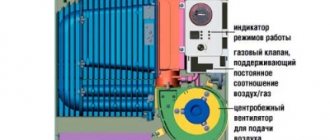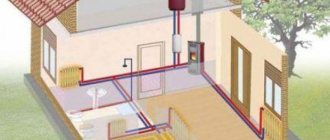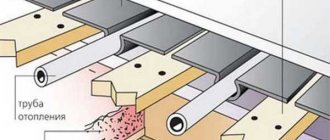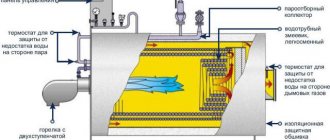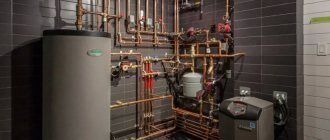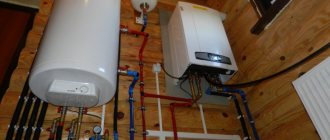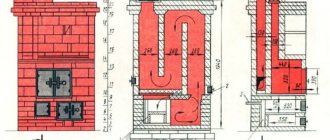The design of a heating system begins with the choice of fuel, the location of the future boiler room and calculations of the cost of heating. Supplying a home with heat is a very responsible matter. Errors will result in additional costs.
The choice largely depends on the area of the room. Today there are several popular heating systems.
Heat generator
High-quality heating in a private home can be based on various types of thermal energy sources, but it must take into account the specifics of wood, especially its tendency to crack at high temperatures, sudden absorption and release of moisture, and deformation during accelerated drying. The following can act as a heat generator:
- bake;
- classic or bio fireplace;
- gas or electric boilers;
- heat pump or gun.
Some options are suitable only for small buildings, others consume a lot of energy resources, others require constant monitoring and manual addition of fuel, and others are high in price and difficult to install. For houses with an area of 80-100 sq. The optimal solution would be to equip a separate boiler room with the installation of a heating boiler, the use of piping, a metal chimney and aluminum or bimetallic radiators, characterized by increased heat transfer. If the house has a gas pipeline or it is possible to connect to a nearby main, it is best to install gas heating equipment, which is characterized by efficiency, durability and high productivity.
It is important to know that in order to legalize gas heating it is necessary to go through approval procedures at Gaztekhnadzor. If you don’t want to clutter the interior with sectional heaters or panels, you can use a “warm floor” system or “warm baseboard”, which will build a thermal curtain along the walls and prevent cold air from entering the room. But no matter what heating algorithm is implemented, it is imperative to take care of high-quality thermal insulation of the walls and roof. Then the heat will remain in the rooms for a long time, and energy consumption will be reduced to a possible minimum.
When laying communications, it is necessary to avoid damage to elements of supporting structures so as not to disturb the uniform distribution of loads of walls, floors and roofs. It is also necessary to avoid direct contact of very hot and condensate-covered pipes with wooden surfaces . To do this, insulation of both heating communications and water supply is carried out. This simple action helps prevent drying or excessive moisture in the wood.
Subtleties of radiator selection
Radiators are one of the most important components of the system. After all, they distribute heat throughout the living space. Therefore, their choice should be taken with full responsibility, and not buy the first product you come across.
Batteries are divided into categories depending on their design and the material from which they are made. Since a wide assortment can drive an unprepared buyer into a dead end, before going to the store it is necessary to understand the advantages and disadvantages of each type.
Aesthetics of aluminum structures
Such products appeared in Italy more than 35 years ago. Since their invention, aluminum heating radiators immediately became popular and won the recognition of professionals.
When choosing a heating radiator, first of all you should familiarize yourself with the material of the sections. The heat transfer of the battery, its service life and weight depend on it
And this is not at all surprising, because these structures are distinguished by their lightness, high heat transfer, and attractive design. But they are poorly resistant to corrosion and are susceptible to airing.
Aluminum batteries can be cast or extruded. The first type is a monolithic structure, and the second is a blank formed by a press, from which finished products are subsequently cut.
Cast structures are considered more reliable and durable. In other respects, their analogues are in no way inferior to them.
Aluminum batteries are relatively lightweight. This makes them easy to transport and connect, something you can do yourself
Panel steel radiators
Steel is an excellent heat conductor. Therefore, batteries made from it are considered the most effective and are recommended for installation by all specialists. In addition, they are a monolithic structure, which greatly simplifies installation.
Provided that steel radiators are used in a house or country house with an autonomous heating system, they have no disadvantages. If all recommendations are followed, the service life can reach 30 years.
Batteries of this type are often supplemented with heat exchangers. But this in no way affects the appearance of the structure.
Good old cast iron
Cast iron radiators were first used more than a century ago. But even today they have not lost their relevance and are actively installed in heating systems.
The reason for this is its ease of maintenance and simply enormous service life - cast iron will faithfully last for about 50 years. At the same time, it retains heat well. The products take a long time to heat up, but after turning off the heating they will heat the room for a long time.
Taking into account all their advantages, cast iron appliances have only one insignificant disadvantage - they are heavy. Thus, the weight of one section can reach 6 kg, and the weight of the entire battery can be 36 kg.
Even in comparison with bimetallic and aluminum products, cast iron structures are a good and universal solution with many advantages
Tubular radiators made of steel
Tubular batteries, as a rule, are classified as products in the highest price segment. They fully comply with all quality standards and have a number of advantages over their analogues.
First of all, such structures can easily withstand sudden changes in pressure, and in the event of a heat cut, the battery will not become air-filled.
Also, tubular radiators have a smooth surface both outside and inside. Thanks to this, they have an attractive appearance, due to which they will harmoniously fit into any interior.
Tubular steel radiators are an expensive proposition. But at the same time, they last for about a quarter of a century, which completely pays for the costs.
Modern bimetallic structures
These types of batteries are made from an alloy of aluminum and steel. These metals have completely different characteristics, and as a result of their combination, a material with excellent performance is obtained.
More precisely, these radiators show high thermal conductivity and can easily withstand water hammer. If assembled with high quality, bimetallic products last about 50 years. But they are quite expensive.
Even despite the high price, it is better to spend money once and buy a bimetallic radiator from a reliable supplier. Thanks to its long service life, it will fully justify the investment.
Built-in floor convectors
This heating device is a tube made of copper and aluminum through which the coolant moves. The main advantage of floor convectors is the ability to build them directly into the floor.
In this case, the structure does not take up precious residential square meters, but at the same time warms the building well. The only thing that comes out is the decorative grille or panel.
If installation is carried out incorrectly, drafts may form inside the room. In addition, you need to carefully monitor the cleanliness of the heating element - air flows carry dust well.
It is better to choose a floor convector made of copper, steel or aluminum. In this case, the structure will last a long time, and the house will warm up almost instantly
Selecting a coolant for water heating
The most popular is the hydraulic heating system, which is characterized by efficiency, ease of maintenance and long service life. The coolant fluid, circulating through a circuit of pipes, brings heat to the heating devices and returns to the boiler for heating. Water is most often used as the working heating medium . But such a coolant is not suitable for houses that are used as temporary suburban housing for weekends or holidays. When leaving, the heat generator must be turned off. To prevent water from freezing and damaging pipes and radiators in cold weather, you will have to regularly empty and fill the system. This is not only inconvenient and takes up a lot of time that could be spent heating cold rooms, but it is also harmful to the equipment. Fresh water is rich in salts and oxygen, which are the main sources of corrosion and solid deposits on the walls of pipes and heat exchanger.
non-toxic antifreeze based on propylene glycol as a coolant (there are several types of antifreeze based on various substances, with different characteristics, including expansion. Some coolants, for example propylene glycol, in combination with polypropylene pipes are recommended for use only in systems with forced circulation. A coolant based on glycerin does not have this disadvantage, but is much more expensive in cost.), retaining its properties under strong cooling. Such a working environment is designed to last up to 10 heating seasons, which fully justifies the initial costs. In this case, there is no need to fill the pipes with pure antifreeze; it is enough to use its mixture with water. The proportions of the composition are determined by the actual climatic conditions and maximum winter temperature:
- down to -20C (65% water, 35% antifreeze);
- up to -25C (60% water, 40% antifreeze);
- down to -30C (55% water, 45% antifreeze);
- up to -35C (50% water, 50% antifreeze).
If the mixture for the heating system contains 55-70% antifreeze, the liquid does not freeze at temperatures below -45-65C, which is more than enough even for northern regions.
The main disadvantages of antifreeze coolant include its reduced heat capacity compared to water (by 15%), expansion ability, increased viscosity, fluidity and aggressiveness towards rubber, which is why all detachable connections must be sealed with special stable gaskets . In addition, it is necessary to use boiler equipment, pipelines and distribution systems, in which the use of antifreeze solution is technically provided, more powerful batteries, and to abandon certain types of polymer and galvanized pipes. At the stage of designing heating in a private house, all these issues can be easily resolved and make it possible to obtain a heating system ready for use.
Aluminum heating radiators
Aluminum radiators appeared on the market relatively recently and have become popular due to their appearance. However, in addition to their beautiful appearance, they have a lot of limitations, mainly related to their characteristics. Don't install them without thinking.
Aluminum radiators have high power and quickly heat up the room, spending much less coolant than, for example, cast iron ones. Like steel, aluminum radiators fit perfectly into any interior.
Due to its chemical properties, aluminum is resistant to alkaline environments. Therefore, when installing aluminum radiators in your home, be prepared for the fact that you will have to constantly monitor the quality and pH of the coolant. The pH should be from 7 to 8, and even drinking water does not always have such indicators.
There are other nuances when installing aluminum radiators, so it is better to entrust their installation to professionals.
Schemes for water heating of a wooden house
Heating systems can be with natural (gravity) or forced circulation of the working environment. In the first case, the laws of gravity and the temperature difference between the heated and cooled coolant are taken into account. In the second, the liquid moves due to pressure pumped by a special circulation pump. To deliver heat to heating devices, single-pipe or two-pipe circuits are used.
Single pipe heating system
To better understand the efficiency and operating principle of a single-pipe heating system , let's consider its installation using the example of a wooden house with several floors. Let us immediately clarify that the presence of a single circuit provides for the rise of hot water to the highest point of the system due to its lower density and mass compared to the cooled liquid. This provides the initial impulse for gravity flow. Moving along the main line, the coolant sequentially passes through the heating devices, giving each part of the accumulated heat. The uneven distribution of thermal energy between the upper and lower floors is immediately noticeable. For a small one-story wooden house this difference is insignificant, but for spacious and tall buildings it is of key importance. An increased number of sections on the radiators farthest from the boiler will allow the temperature levels to be equalized.
Scheme of a single-pipe heating system
In order for the cooled working medium to be able to return by gravity to the heat exchanger for heating, the heat generator must be placed below the level of the radiators . The use of a circulation pump eliminates this requirement and makes heating in a private home much more efficient due to the accelerated movement of the working medium.
In a simplified form, the installation of a single-pipe heating system can be described as follows:
- boiler installation;
- installation of expansion tank and radiators;
- laying a pipe line;
- installation of a circulation pump (if necessary);
- connecting communications to devices;
- installation of radiator valves.
To improve the performance of single-pipe heating, special jumpers are used - bypasses, which allow redirecting and redistributing the coolant flow along the riser.
Two-pipe heating system
Two-pipe heating system
A two-pipe heating system is much more efficient due to the simultaneous flow of heated coolant into the radiators through a separate line. Having passed through the sections of one heating device, the working medium immediately enters the return line and returns to the boiler.
In addition to uniform heating of all radiators, another important advantage of two-pipe heating is its variability. You can easily add new heating devices and extend the lines in the desired direction. Thus, when completing a house, there is no need to replace the entire heating system.
Choosing the type of heating
Before installing heating for your wooden house, you need to choose the type of heating that will be appropriate in your home and will meet your needs and requirements. The task of installing heat in a house requires a long process of calculation and careful planning. A mistake made when heating your home can be costly. This includes defrosting the entire system and burst pipes with a water heating system. With an electrical connection, this is at least a short circuit.
With an air system, in general, the complexity of dismantling after installation does not make it possible to fix anything.
The choice of heating type for a private home largely depends on what access to energy resources is available. The type of energy carrier for heating a private wooden house can be:
- Gas
- Hard fuel (coal, firewood).
- Electricity.
- Liquid fuel (diesel, kerosene)
The choice of the heart of the thermal system – the boiler – depends on which source will be used.
Important nuances of heating in a wooden house
Expansion compensators
As already mentioned, the main features of installing a heating system are related to the use of wood as the main building material of the house. Even well-dried timber contains a certain amount of moisture and, over time, dries out and can be partially deformed. On the scale of an individual structural element, such changes can be considered insignificant. But given the large areas of wall, floor and ceiling surfaces, shifts become critical and can amount to tens of centimeters. The use of standard communications and rigid fastenings will lead to bends (ruptures) of pipes , destruction of interpipe connections and insulation, and damage to equipment.
Bellows compensator for heating system
That is why special expansion joints , which are equipped with a corrugated surface, are resistant to dynamic loads and have the ability to compress and stretch . Sliding fasteners ensure freedom of pipe movement. Open installation of pipes often violates the overall aesthetic integrity of a wooden interior, so it is advisable to give preference to hidden installation of communications.
Laying and routing of pipes
- Pipes are laid under the floor, in interfloor ceilings, behind false walls. It is important to determine in advance the exact location of the pipework . Experts strongly recommend using collectors and equipping communications in such a way that there is not a single joint in the interfloor ceilings and under the floor. This leads to a slight increase in the construction budget, but completely eliminates the risk of leaks in a place inaccessible for prompt repairs.
- The material used for coolant lines is high-quality pipes made of cross-linked polyethylene or polypropylene, which are designed for trouble-free operation for up to 50 years. It is worth noting that the selection of pipes should be carried out taking into account the selected coolant and the wiring diagram of the heating system itself (for example, if ethylene glycol is chosen as the coolant, then the heating system must be with forced pumping of the coolant, otherwise there is a high probability of pipe rupture).
- To install false walls that will decorate communications, you should not use soft insulation materials that are unable to hold their shape on their own. It is best to use special slabs with a perfectly smooth fiberglass mesh coating. They are easily attached to each other thanks to the tongue and groove connection.
- there is a load-bearing beam or wall in the way of laying communications , it is necessary to perform a bypass turn of the pipe and under no circumstances cut wood, reducing the structural strength of the building.
- When laying communications under the floor, it is allowed to make holes in the joists.
- If you want to organize a heated floor system, you cannot use a monolithic concrete screed. There is a convenient Finnish technology for installing communications in a dry screed on a base made of several layers of plasterboard or cement-bonded particle board. Tile adhesive is used to fill voids.
Two-pipe system
Two-pipe scheme
Using this heating system, you can easily achieve the same heating of each installed battery. But unlike a single-pipe system, in this case large financial costs will be required. Each battery must be equipped with shut-off valves that will control the temperature in each individual battery. This heating scheme in a wooden house is used in most cases when gas heating is available. In such a house, you can immediately attach the batteries to the wall or to a pre-installed block. A two-pipe system is installed with a solid fuel boiler.
Shrinkage of walls, pipe insulation
Shrinkage of a wooden structure is a natural process of reducing and compressing walls due to the evaporation of moisture from the pores of the wood. The intensity of this process depends on the type of material used. Houses made of laminated veneer lumber and kiln-dried timber are the least susceptible to shrinkage. But such materials are more expensive. Most often, affordable logs and beams of natural moisture are used, which cause significant shrinkage. Before installing heating in a private house, it is advisable to let it sit for 8-12 months . If this is not possible, pipe installation is carried out using compensators and sliding fasteners.
Thermal insulation of heating pipes
Wood is equally adversely affected by strong thermal effects and moisture in the form of condensation on pipes, which leads to cracking, deformation, mold and rot. The most economical and correct way to eliminate these problems will be to insulate the lines with a special tubular material.
Choosing a boiler
If the source is gas, then it is best to choose an automatic wall-mounted gas boiler. This generator is equipped with a pump and protection. If a chimney is not provided, then you need to opt for a boiler with a closed combustion chamber. And to exhaust air in such a boiler, you can use a coaxial pipe. This will save money on pipe installation.
Wall-mounted boilers already have full automation, but if the water volume is more than 100 liters, install an additional expansion tank, even if there is a built-in one. It will make it possible to compensate for the expansion of water when heated. Otherwise, the pressure in the boiler will increase greatly as the temperature rises, and the automation will often turn off.
If the choice fell on an electric boiler, then it is best to choose a fully automatic boiler, with a built-in pump and expansion tank. This option will be more convenient to install and will avoid many mistakes.
Be sure to use a special device to stabilize electricity for such a boiler.
If the fuel is of a hard nature, then such a boiler can be installed by yourself, only if you know how to weld. And they are able to weld heating pipes with their own hands. The outlet temperature of this type of boiler can reach 100 degrees and it will be difficult to install any pipes other than iron ones without the help of professionals.
You can also use plastic pipes in a system with a boiler powered by hard fuel, but a special decoupling is required. Only highly professional heating engineers can carry it out.
When the boiler is selected, you need to select the right pipes and radiators. Various materials are used for pipes today. But when installing it yourself, it is best to use plastic. It is easy to install. The quality of metal pipes today has deteriorated greatly. So from the proposed option, choose metal-plastic or polypropylene.
The material has been selected, all that remains is to draw a diagram and choose a project for your home. The project will depend on the type of heating you choose.
Radiators are chosen depending on what kind of heat transfer you want to get and which ones suit your interior. The larger the radiator sections, the warmer the house will be. The calculation is 1 section per 1.5 square meters.
The appearance of radiators should not spoil the overall appearance. You will make the right choice by watching the video:
Calculation of materials is carried out after drawing up a detailed diagram of the heating system of your home.
For a wooden house, radiators with a bottom entry are usually used. This is due to the fact that it is difficult to hide pipes in the wall of such a house. They are hidden under the floors between floors.
Installation of a chimney or boiler room
The chimney can become very hot during operation of the heat generator, which carries a significant risk of wood fire. Therefore, it is necessary to use certified chimneys made of fire-resistant materials with insulation. The best option is considered to be a free-standing brick chimney with its own foundation, which rises above the house to a height of up to 2 meters.
This design provides excellent traction, effectively removes combustion products and reliably protects a wooden house from temperature effects. Installation of a gas boiler must be carried out on a fire-resistant floor or wall base. If a solid fuel heat generator is used as a heat source, it is necessary to take care of a full-fledged boiler room in which all horizontal and vertical surfaces are not hot.
The article was written for the site.
Tags:Heating boiler, Heating radiator
Heating system design options
Gas heating of a wooden house with your own hands can be done in accordance with two schemes:
- The first option is the use of traditional double- or single-circuit boilers. The advantage of using such units is their autonomy of operation. For example, many foreign-made models are used on a “set it and forget it” basis.
Economical, easy-to-use wall-mounted boiler
Such a device, being equipped with a thermostat, independently maintains the specified temperature parameters. In addition, if you are away for a long time, the boiler will automatically circulate water through the system once a day so that it does not stagnate.
The photo shows domestic products of the Junker brand
A significant advantage of Western European boilers is their efficiency. The fact is that this equipment was initially designed for countries where the cost of natural gas is high. Therefore, such installations are an order of magnitude more economical and more powerful than domestic designs.
The boilers are ergonomic, regardless of whether you purchased a floor-standing or wall-mounted model. And finally, such installations are fireproof.
Among the disadvantages, it should be noted the need to draw up and approve a heating system project. In addition, the price of truly high-quality imported equipment is high.
- The second option is to use a gas convector. This solution is the best option if there is no prospect of connecting to the main line, and gas is sold only in cylinders.
Convector with removed protective casing
The disadvantage of convectors is the ability to heat a limited space. Therefore, if the construction project is multi-room, you will have to invest money in the purchase of several devices, and accordingly the price of the heating system will be high.
Gas convector operation diagram
Another disadvantage of converters is their limited functionality. For example, if a boiler heats a room and heats water for consumer needs, then a convector only heats it.
Article on the topic: The better way to paint a wooden house with a brush or spray gun
Chimney installation in a wooden building
The instructions for exhaust gas removal are largely determined by the type of heating equipment:
- When purchasing a modern gas boiler with a closed combustion chamber, you can count on the installation being equipped with forced exhaust. This hood is a neat compact pipe with a diameter of no more than 100 mm.
An axial fan is built into the pipe, consuming no more than 100 W. By installing the exhaust pipe into the hole made in the wall, the gap at the edges of the chimney is filled with foam.
- The installation instructions for boilers with an open combustion chamber are different. In this case, you will have to build a full-fledged chimney that will pass through the roof.
Natural exhaust project
The main requirements for such chimneys are the absence of direct contact with wooden structures. In addition, the exhaust gas removal device should not have more than three bends.
Of course, when constructing a chimney and when connecting it to heating equipment, it is necessary to ensure absolute tightness in order to exclude the possibility of carbon monoxide entering the room.
Important: In order to comply with fire safety regulations, it is advisable to purchase a ready-made thermally insulated chimney.
Sandwich systems have a layer of thermal insulation located between two metal shells. Therefore, during installation, such structures can be leaned directly against the elements of the rafter system or against other wooden structures.
Location of heating equipment
The instructions for the location of heating equipment are largely determined by its design and operational features.
Let's consider where and how to mount gas-fired heating units:
- From the point of view of air exchange efficiency, it is advisable to place convectors directly under the window opening . The front edge of the device should protrude slightly forward beyond the line of the window sill.
Of course, for safety reasons, it is not recommended to use fabric curtains on the window opening. You can limit yourself to installing plastic or metal blinds directly in the window opening.
- Mounted heating boilers with a closed combustion chamber and forced exhaust can be installed almost anywhere where it is convenient to connect all the necessary communications . For the installation of floor-standing boilers, it is advisable to allocate a special room.
Important: Both types of heating equipment are installed and operated in accordance with a specially developed and approved project.
- Heating boilers with an open combustion chamber are installed exclusively in specially designated rooms with a specially equipped exhaust gas removal system and ventilation arranged in accordance with the design documentation . Just like the previous categories of heating equipment, boilers with an open combustion chamber require a specially developed and approved project.
Article on the topic: How to make a bathroom in a wooden house
Chimney device
According to fire safety rules and in accordance with the requirements of gas services, the boiler room must have a chimney and an exhaust hood; this must be taken into account when installing gas heating in a wooden house.
A large vertical chimney is necessary when installing a boiler with an open combustion chamber. A small chimney is sufficient if the combustion chamber of the gas boiler is closed. Such boilers provide for the creation of forced draft, which means that a pipe with a diameter of 10 cm will be sufficient to remove combustion products. The hole prepared for it must be paved with fireproof material. There is no need for constant ventilation, since the air needed for the burner comes from the street, which cannot be said about boilers with an open chamber. For them, the room must be constantly ventilated.
Article on the topic: The better way to paint a wooden house with a brush or spray gun
When heating a wooden house, a so-called chimney is used - a “sandwich” (insulated metal pipe). The hood is made from it. Since the channels cannot be installed inside wooden walls, they are taken outside and raised up the wall from the outside.
Despite the great effectiveness of the method, problems also arise. When severe frost sets in, the thermal insulation of the pipe may not be so reliable. As a result of cooling, the air inside the “sandwich” descends into the chimney and hood, a kind of plug is formed, causing the draft to appear in the opposite direction or disappear completely. The combustion in the gas water heater stops, the boiler room cools down, and the house stops heating.
Chimney arrangement diagram
Despite the presence of thermal insulation, insulated pipes should be installed in the heated part of the house, and a smaller part of them should be brought to the roof.
Chimneys can also be made of brick (built-in or attached). When installing such chimneys, it is necessary to plaster the internal walls of the structure.

